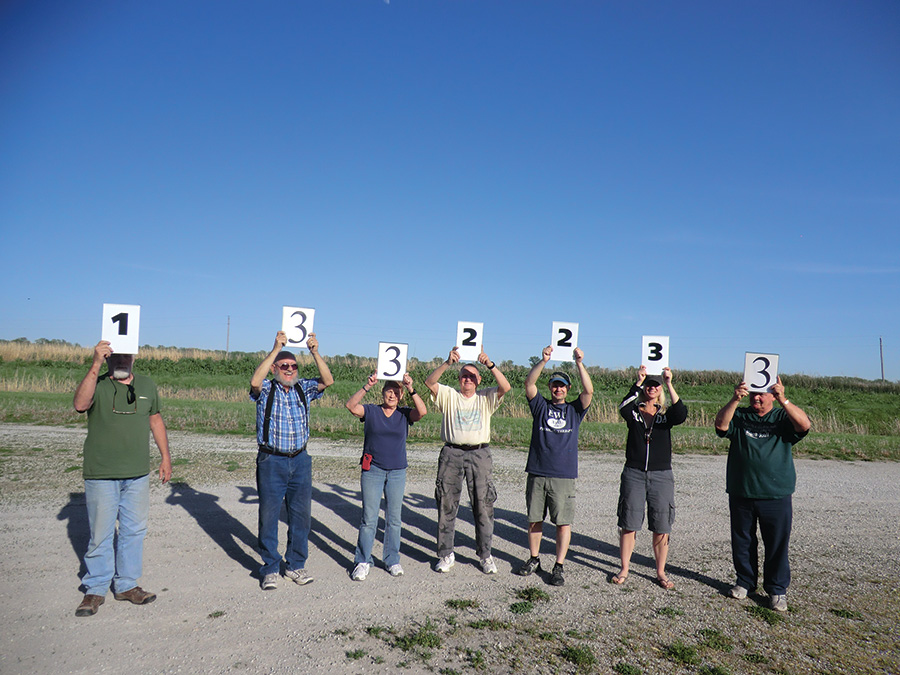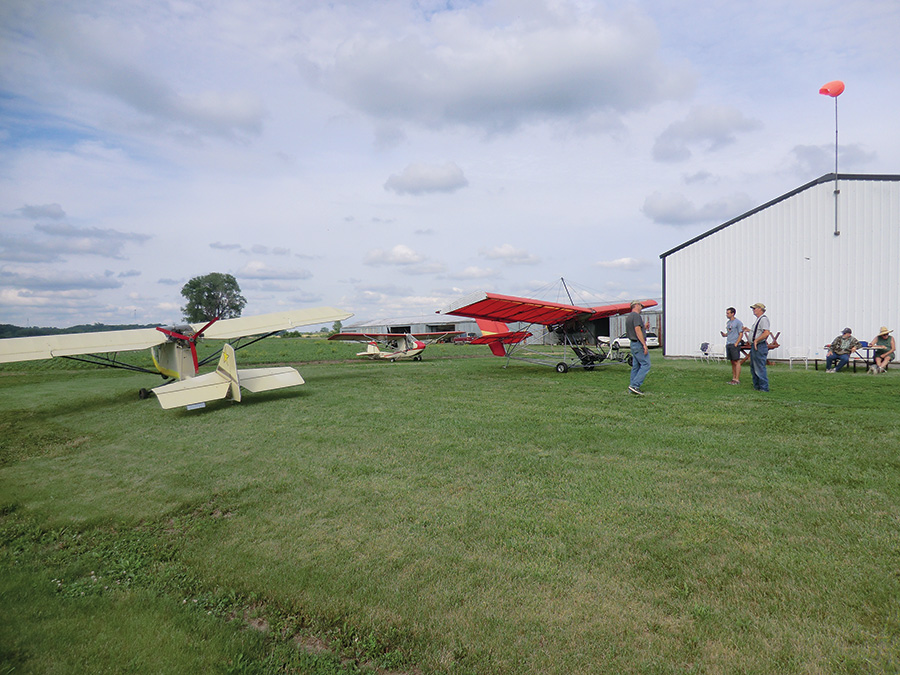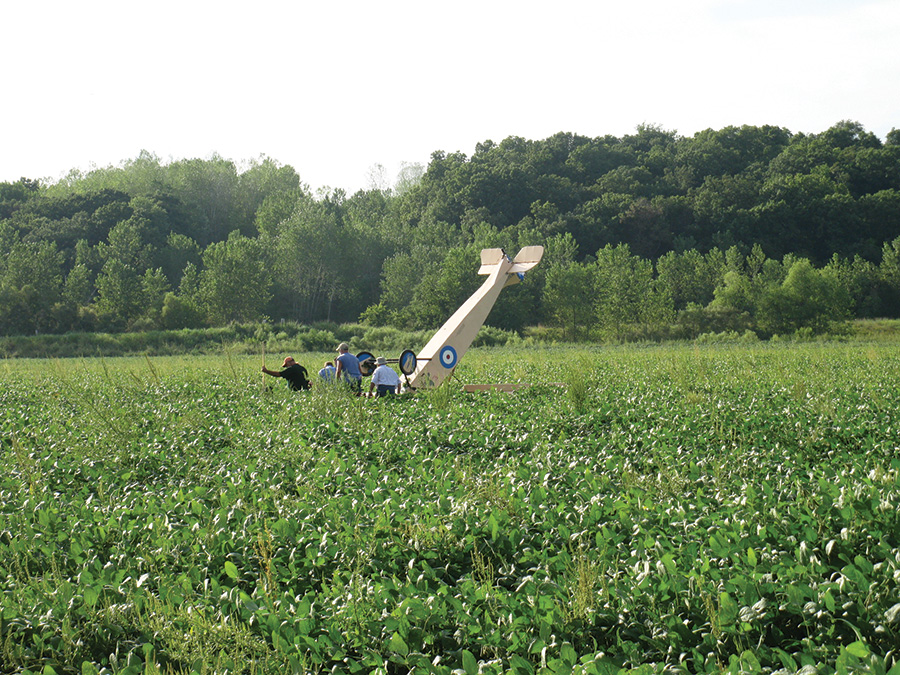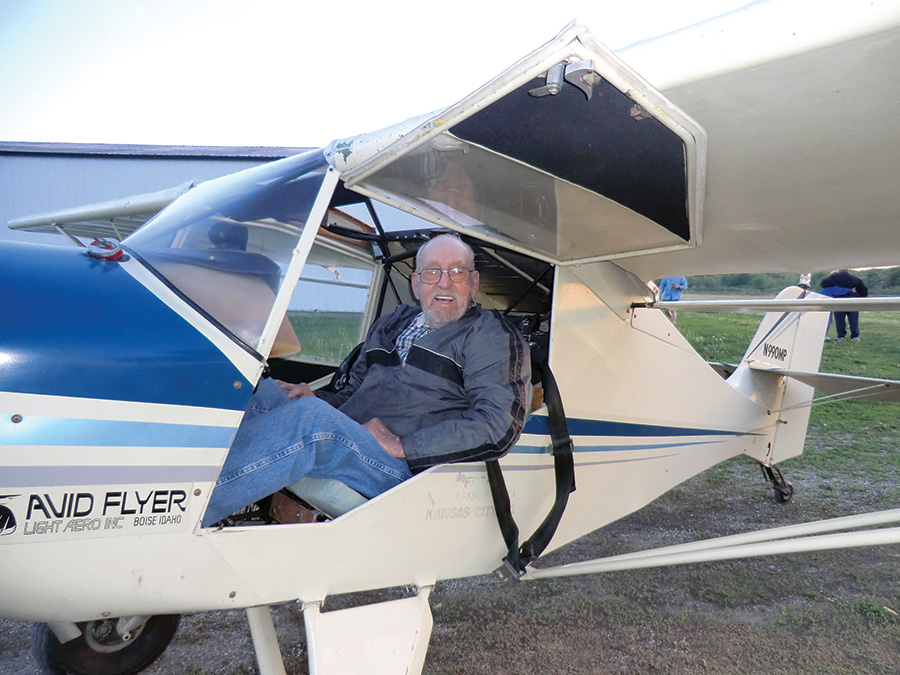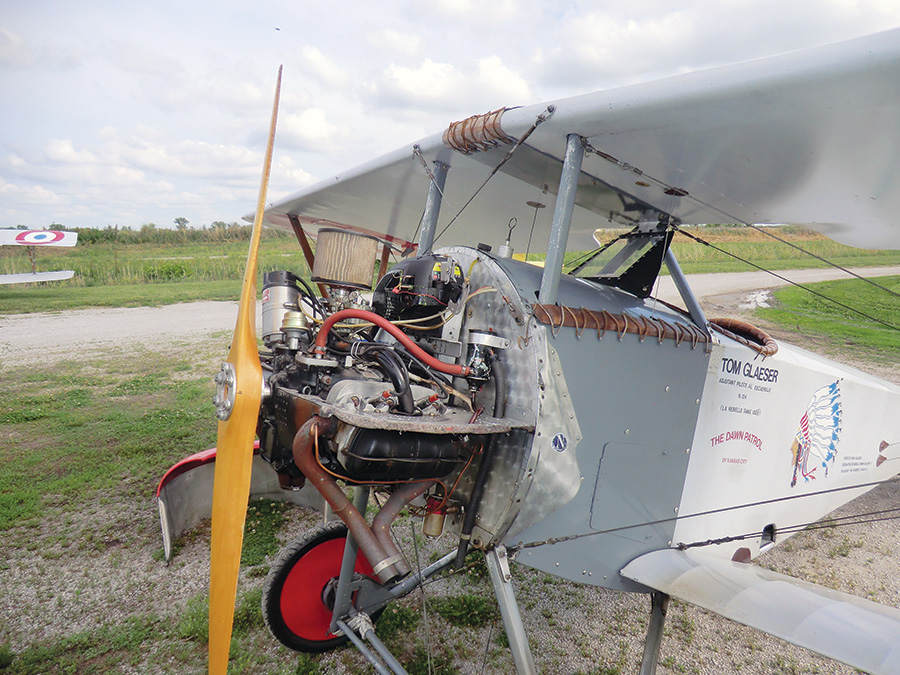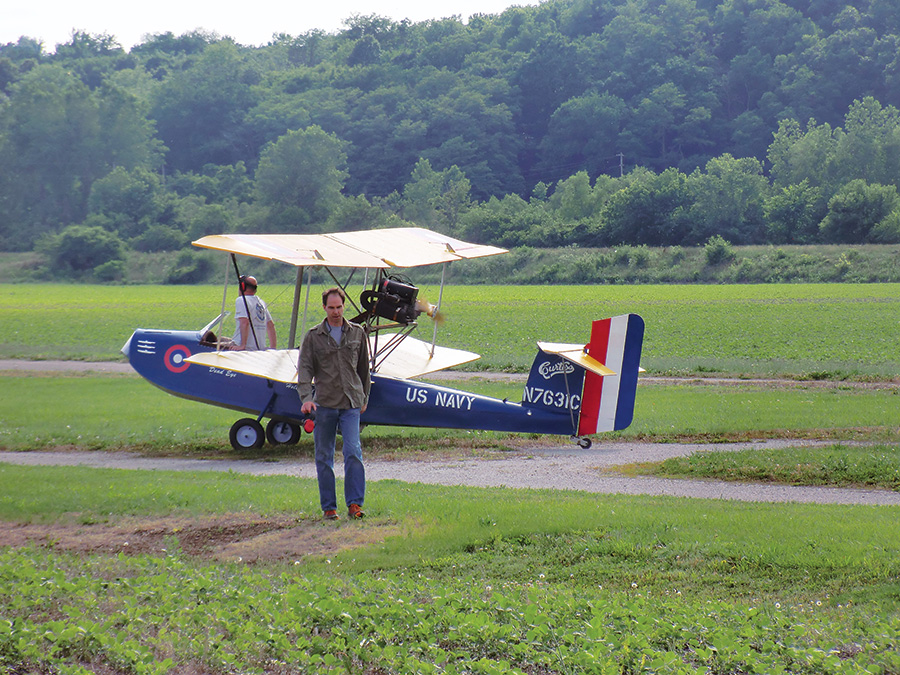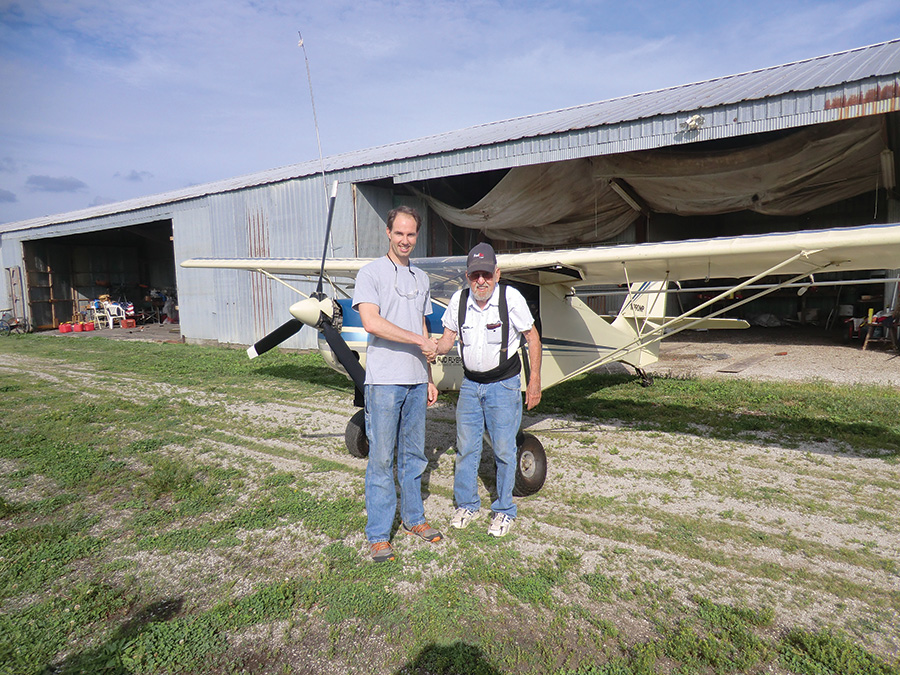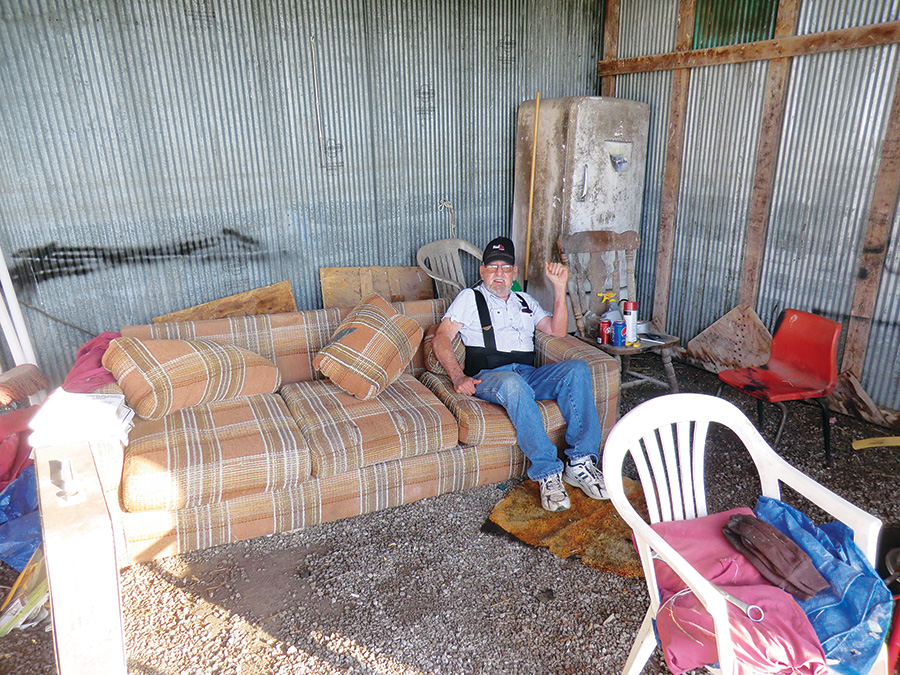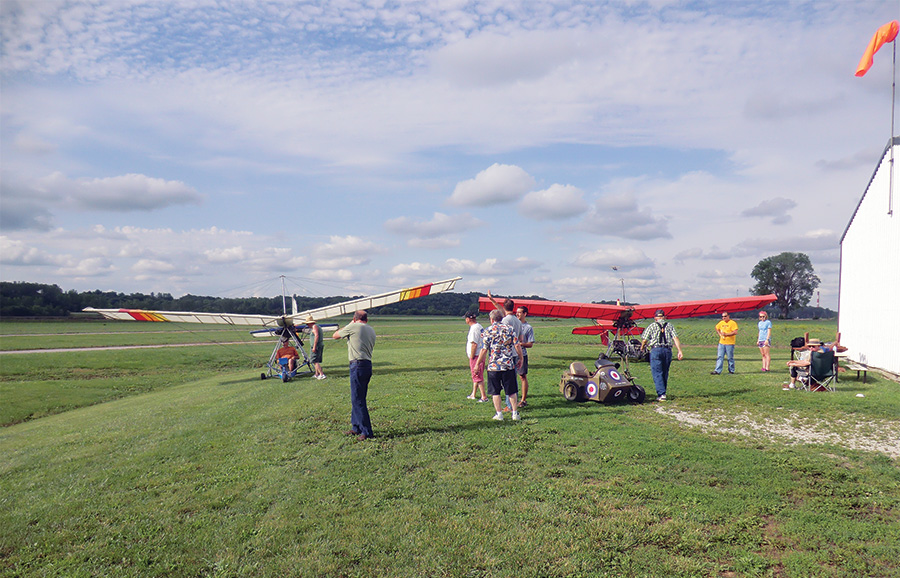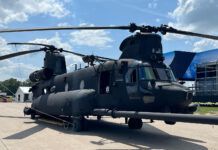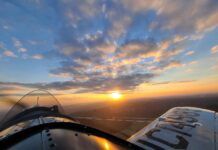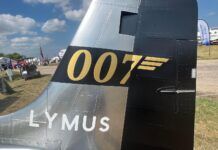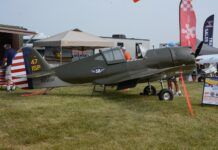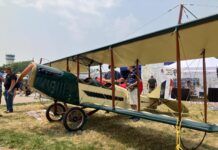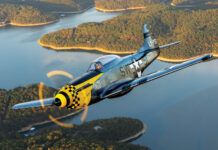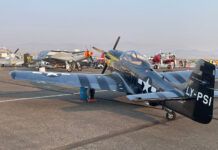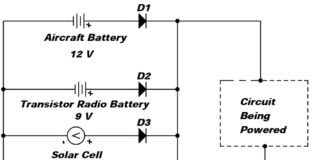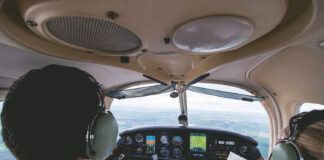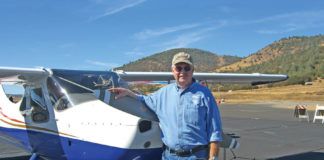“Oh no,” Bob moaned, “Will you just look at that!”
Harvey looked around quickly—”What?…Where?…Is something wrong?”
Bob was looking worried. “Those idiots are getting out the numbers.”
Harvey just smiled. He knew what was coming and grinned in anticipation.
This is what Bob and Harvey saw as they turned from the taxiway to go to Bob’s hangar. From left to right: Jerry (Rotaxman) Sharp, Dick Lemons, Sharon Starks, Dick Starks, Dave Laur, Mary Batson, and Fred Porter. I personally think Jerry was being a little hard on Bob, but Jerry just wanted to see Bob’s hangnail again.
Yep, it was time for a time-honored Liberty Landing International Airport tradition. You don’t get to do things like “The Numbers” at big metropolitan airports, with towers, paved runways, taxiways, and all that modern stuff. Thank goodness we don’t have any of those modern frills at our little airport with its 1700-foot runway of turf, gravel, sand toads, and the occasional deer or coyote standing on the runway to add interest to your landings.
Yessir, Liberty Landing is one of the rapidly disappearing, no-amenities grass strips that are scattered all over the country, mostly in rural areas. But in our case, we are located fairly close to a large city. In fact, when we are at pattern altitude (500 feet for us) we can see the Kansas City skyline etched very clearly on the western horizon.
Liberty Landing International Airport is the unofficial home of The Kansas City Dawn Patrol’s WW-I replicas. Also at the field is a pretty good cross-section of Experimental aircraft, including RVs, Avids, Starflights, Kolbs, Quicksilver ultralights, and a smattering of classic taildraggers. Not one “spamcan” is there to clutter up the tarmac.
It was a typical flying day at LLIA and was composed of anyone flying who wanted to, lots of hangar talk, aircraft maintenance, hangar talk, hot dogs and hamburgers on the grill, hangar talk, and elaborate practical jokes. Tom Glaeser was arguing with his chain-saw starter on his Graham Lee Nieuport 11. Dick Lemons was muttering over the carburetor on his Quicksilver Sprint. Sharon and I were mournfully looking at some new hangar rash on the right aileron of her Kolb TwinStar MK-II. The rest of the airport bums were experiencing the most enjoyable activity of all, watching other pilots land. Now that’s quality entertainment.
Just part of the ramp in the back of the white hangar on a typical late summer afternoon of flying at beautiful Liberty Landing International Airport.
This particular day we were anticipating an unusual ultra-high-quality aviation spectacle. Yep…one of our airport regulars was out doing touch and goes with our favorite instructor, Harvey “Hollywood” Cleveland. His student was learning the mysteries of taming the taildragger. Hollywood was the pilot of Sharon Starks’ (My Sweetie) Airdrome Airplanes Morane-Saulnier “L” Parasol in the opening moments of the movie Amelia. (That story can be found in the November, 2008 issue of KITPLANES® Magazine or in my book, Fokkers at Six O’clock!! )
Anyway, Harvey is the designated test pilot of all of Robert Baslee’s Airdrome Airplanes replicas. Harvey has also “starred” in several movies flying some of Robert’s designs. They filmed a movie on location this winter in the deserts of southern Nevada using one of Robert’s full-size Fokker DR-1 Triplanes, and his newest design, the full-size SE-5A.
The infamous airplane-eating ditch snares another plane. In this case, Hollywood Harvey’s Champ. He was giving a lesson in it when the right brake locked up on him and a student on roll-out. The sound of that prop splashing through the water in the ditch was a sound you’ll never forget.
We’ve all had some lessons with Harvey, and all of us usually get our biannual flight reviews from him in his Champ (and a real workout it is, too!).
Now, watching the transformation of a pilot from nosegear to taildragger is an event that normal people would pay good cold hard cash to see. Well…we get it for free, but it really is worth paying for. There are moments of sheer pulse-pounding drama that rival anything you’ll ever see on the silver screen.
Bob Loyd (AKA Big Bad Bob) was the poor soul with Harvey, training in Bob’s Avid A model.
This is what it looks like when you land in a field of green soybeans that has not been harvested. It’s a very soft landing but you will not stay upright. Sharon’s Morane is being moved back to get on its gear after being totally upside down. (See Kitplanes® October, 2012, Sharon’s Combine Service.)
Big Bad Bob is an airport fixture at LLIA. He’s our own patented curmudgeon. Bob redefines the term “airport bum.” He’s always out there, even on the hottest days of the year, sitting on a ratty old moth-eaten couch in his hangar, waiting for the winds to drop and the bumps to fade away so he can go fly. For years Bob had flown various ultralights until, in a momentary lack of reason that still escapes him and us, he sold his ultralight, crossed over to the dark side, and bought a Cessna 150.
Now, I’ve gotta say that all his ultralights, like the C-150, were nosegear planes. Anyway, he realized after a while, just like I did, that the feeding and upkeep of a certified plane like the 150 was just the same for him as it was for me with my ’46 C-120—it was costing waaay too much $$$$ for the time spent in the air. After all, this is a hobby.
So, Bob sold the 150 and bought an engineless Avid A model. A six-month period of time was used to adapt the Avid to a 65-hp Rotax 582. It was going to turn the Avid, which had been using a Rotax 447, into a fire-breathing little raptor of the skies.
But first, Bob had to get his conventional (taildragger) certification from a CFI. Now, I don’t know what it’s like where you live, but finding a CFI who is certified to teach conventional gear and has access to a conventional-gear aircraft is sometimes a daunting challenge. When I got my ticket back in ’79, I was lucky that, number one, I had a taildragger to learn in, and number two, there was an instructor with a ’46 Swift right there at Noah’s Ark Airport who was willing to take me on. The rest is history. (If you want more details, get my first book from Amazon.)
Harvey Cleveland walks away from his 1918 Curtiss Seagull replica (actually a Mariner Amphibian) after turning Dave Laur loose in it to give it a try.
So, let me set the scene. We all knew what was getting ready to happen. All work at the airport ceased. Chairs were brought out and placed where we all had a great view of the runway. We were all sitting in a line parallel to the runway. Now, LLIA is small. Our line of chairs was only about 100 feet from the runway. Between the runway and us is a ten-foot wide gravel taxiway. Between the taxiway and the runway is the infamous Liberty Landing Airplane Eating Ditch. The runway is next, which might be fifty feet wide. On the other side of the runway, at this particular time, was a recently harvested soybean field. This is probably the best emergency field you will ever find. I’ve landed on grass airports whose runways aren’t as smooth as a harvested soybean field. As a matter of fact, all of us in The Dawn Patrol have at one time or the other been in a soybean field. Trust me on this…harvested is best. Three foot tall beans promise a soft landing, but you’ll always end up on your back looking up at the soybeans.
We were all lined up there, cameras ready and drinking hearty frosty cans of Diet Dr. Thunder. Harvey and Bob were going up and down the runway with occasional forays into the bean field. Harvey had told Bob he was just there to make sure Bob stayed out of the ditch. But when Bob was determined to head to the field, Harvey let him do the dirty deed. Harvey was there to help Bob learn the taildragger tap-dance and not tear up his plane. There were some exciting moments with dirt clods flying accompanied by clouds of soybean remains as they wove a sinuous path through the soybean field.
After about an hour of that, accompanied by appreciative ohhhhs and ahhhhs from the watching crowd, they started doing touch and goes. Now it was getting really interesting. The ohhhhs and ahhhhs were punctuated by several instances when the audience jumped to its feet watching things unfold. Several more “soybean soirees” were experienced, but it was soon apparent that Big Bad Bob was catching on. As time passed, there were no more wild swerves on the runway, and takeoffs were pretty much straight down the pike.
When they made one last landing and didn’t convert it to a touch and go, we decided it was time to get out the numbers.
At a garage sale several years ago, I was able to find a bunch of large flip cards that went from zero to five. They are like what you see scorers give divers in a dive competition. I whipped up a bunch more on my computer, printed them off, took them to Staples and got them made into the same kind of flip cards I’d bought at the garage sale.
Big Bad Bob waits for the winds to go down and the bumps to go away in his seat of comfort in his hangar at Liberty Landing International. Lately there were reports of a big black snake in his hangar behind (or in) his couch. Until that rumor is proven wrong, he’s not taking any more naps on the couch like he usually does.
I can tell you from bitter experience that when you’re on downwind getting ready to turn base and you see the line of chairs beside the runway with the rest of the airport bums sitting there with their flip cards, your pucker factor goes up a few more notches. It really centralizes your thoughts on short final.
Bob and Harvey exited the runway up by the big cottonwood tree and headed back our way on the taxiway.
We all stood and lined up beside the taxiway going back to Bob’s hangar and got ready. Scores were chosen. (Five is the best you’ve ever seen. Zero is “Go get the trailer, boys!”) As Bob and Harvey turned onto the taxiway, on the count of three, we all held up our scores.
Harvey just smiled. Bob showed us his new hangnail.
Actually, Big Bad Bob had done a very good job. I was out at the field last week after Harvey had finally cut him loose and watched him do some takeoffs and landings. They were OK. The one thing he did that really impressed me, and told me that he was catching on, was how he recovered when one landing started off with a heck of an out-of-control, nose-high bounce. Rather than try to salvage the landing, Bob did the right thing. He lowered the nose, firewalled the throttle, and went around. The next landing was just fine. The world is now his oyster. He’s ready for a summer of flying fun. Big Bad Bob is now a taildragger pilot!
And so, from Liberty Landing International Airport…the adventure continues.

